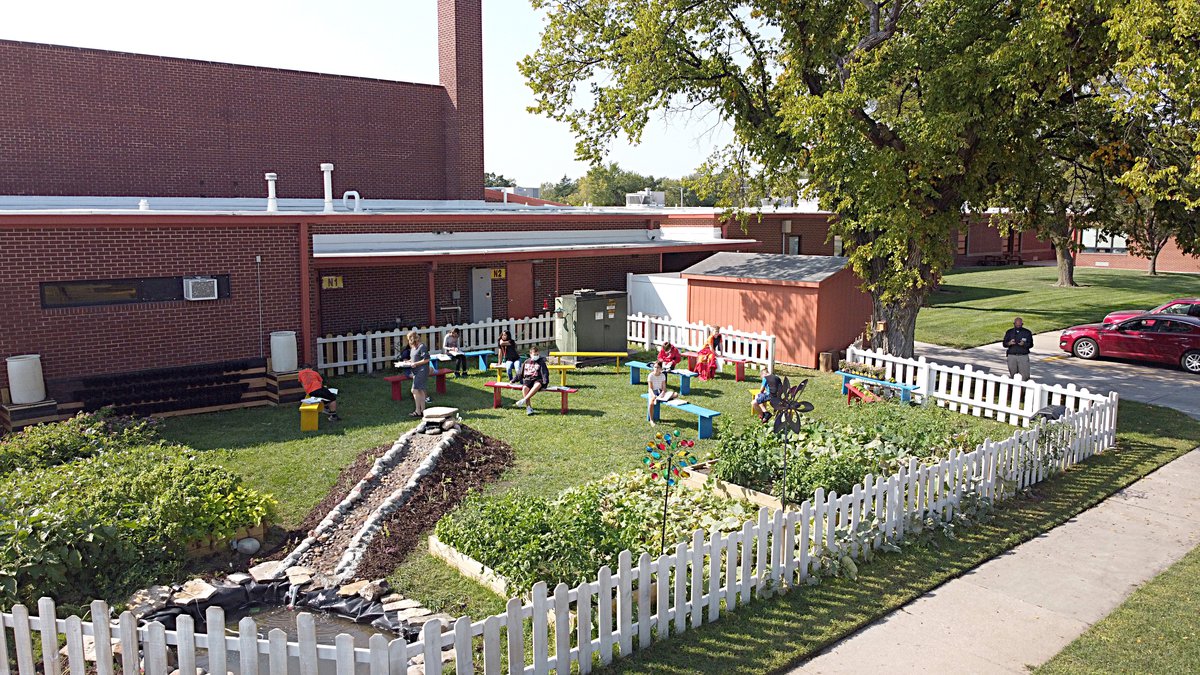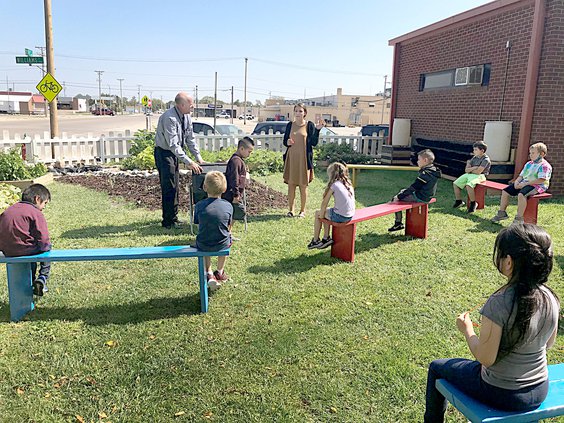As months of work and vision come to fruition, Park Elementary School’s garden has become a place where young minds can grow and flourish in an innovative environment, just like the abundance of greenery that surrounds the budding outdoor classroom.
The project, which began in the spring and continued with hundreds of volunteer man-hours throughout the summer, is beginning to bear the fruits, literally and figuratively, of the vision Park Booster Club members and Park Elementary School administrators first had for the open space.
Park Elementary Booster Club Co-president Brigette Dugas noted volunteers came out each Tuesday night over the span of about 12 weeks throughout the summer, between five and 15 each time, to ensure the space was ready for the start of the school year.
Park Elementary School Principal Phil Heeke noted that the district’s decision to allow summer school, allowing staff and volunteers access to school grounds over the summer, was instrumental in this process.
Even the construction process was a learning opportunity for students.
“All of the volunteers’ kids came with them, so they got to learn how to build a fence, how to construct benches and measure,” Dugas said. “The kids were actually making the cement stream; just lots of skills that normal 8-year-olds wouldn’t be learning.”
As Dugas and the rest of the Booster Club originally envisioned, the burgeoning garden is now used to teach a wide variety of subjects in a unique hands-on way.
Outdoor classroom for all ages
“Every day we have classrooms that come out here,” said Heeke.
Every grade has an opportunity to take advantage of the outdoor learning space.
“The kindergarten couldn’t go to the pumpkin patch this year, so we brought the pumpkin patch here,” Heeke said, noting also that the kindergarten and first-grade classes have been taking care of flowers planted in front of the school, giving even the youngest students a chance to learn about gardening.
The garden has produced a variety of vegetables and plants, including tomatoes, pumpkins, cucumbers, squash, different varieties of peppers, watermelons and much more. It has also borne a variety of native Kansas plants surrounding the garden’s irrigation pond. Occasionally, students have also had a chance to partake of the foods the garden has produced.
The abundance of plants has also given the second-grade classes a chance to learn about composting.
At the higher grade levels, the garden is providing a chance to teach concepts of water conservation and irrigation. A project is in the works for the sixth-grade classes to construct natural irrigation systems to get water from the garden’s rain barrels to the flower beds.
It’s also been a chance to learn about the life cycles of animals. One of the third-grade classes, for example, found a caterpillar in the garden and had the opportunity to watch it develop into a butterfly before releasing back it into the garden.
The garden has flowers and other plants for the purpose of attracting insects to provide another learning opportunity for students.
“The kids are out here looking for bugs and all kinds of cool things,” Heeke said.
But it is not just science concepts the students use the space to learn about. Teachers have utilized the space to teach everything from math to reading, as well. Heeke noted it provided an ideal space for that, also.
“The teachers can come out and teach, and it’s set up to where a whole classroom can be out here,” Heeke said.
Along with the benches, stumps provided by the Great Bend Tree Board provide enough seating for a classroom of 24 students to be outdoors in a socially-distanced setting.
Heeke also noted that having the wide-open outdoor learning space has been ideal for the emotional health of students in a time where the in-person learning environment has changed drastically for students.
“We hadn’t planned that, but it just worked out so well for us this year, that can we get the kids outside,” he said. “And the weather’s been beautiful for it.”
He noted the seating is set up in such a way that students are able to sit at least 6 feet apart, and whether learning or not, it gives them the opportunity to take a break from wearing masks that are part of every school day this year.
Even principles of physics are taught. Kindergarten teacher Leah Yancey has expressed interest in helping construct a sound board on the back wall to help teach her students about sound, Heeke said.
Moving forward
As much progress as has been made in the classroom, Dugas and Heeke noted it is still a work in progress, with an even grander vision going forward.
The garden has been certified by the Kansas Department of Wildlife, Parks and Tourism as an Outdoor Wildlife Learning Site. According to the KDWPT website, the OWLS program provides funds for “an outdoor environmental/wildlife laboratory, at or near a school, consisting of one or more native habitat features.” Along with grants already received, this will allow the school to apply for additional grants to improve the space going forward.
One vision for this, Dugas noted, is to potentially power the space completely off of sources such as solar and wind energy, to teach the students about renewable energy sources in the process.
Dugas also noted in the spring they would like to add fish to the irrigation pond, to help teach students about symbiotic relationships and how animals and plants work together to produce thriving outdoor habitats.
Seeds donated by the Central Kansas Dream Center, by way of Walmart, will also allow students to explore different indoor and outdoor methods of gardening when new plants are planted in the spring.
“There’s just a lot of different directions we can continue to grow in,” Dugas said.
Art is also in the long-term vision for the garden space. The white picket fence posts surrounding the garden will eventually contain painted student self-portraits, to add extra vibrancy to the space.
It takes a lot of people invested to make this vision a reality.
Along with the other groups and individuals mentioned who contributed countless hours of labor, as well as funds and supplies, Dugas said community partners like Sutherlands, Stone Sand Co., Great Bend Co-op, Jason Causey with Rainmaker of Great Bend, Stutzman’s and Dillons have been significant contributors to the effort.









